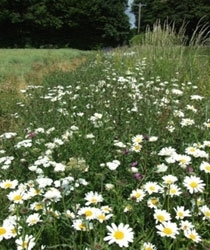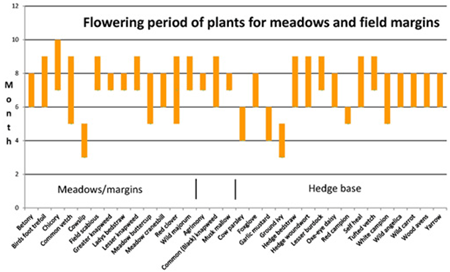 This habitat can be one of the most beneficial and attractive habitats, if properly established, and should be a feature on all farms. The aim is to provide a mixture of native grasses and wildflowers that will support a broad range of invertebrates including pollinating insects, plant feeding insects such as grasshoppers, bugs and butterflies, and predatory invertebrates such as spiders and beetles.
This habitat can be one of the most beneficial and attractive habitats, if properly established, and should be a feature on all farms. The aim is to provide a mixture of native grasses and wildflowers that will support a broad range of invertebrates including pollinating insects, plant feeding insects such as grasshoppers, bugs and butterflies, and predatory invertebrates such as spiders and beetles.
Birds will make use of it for foraging and nesting, however, for the birds to gain access to the insects the sward must be relatively open. It will also become home to a variety of mice. Most of these groups have declined in recent decades on farmland and are in need of help.
Wildflowers can be established either by sowing or through natural regeneration. However, we would recommend sowing because natural regeneration will most likely just develop into a grass sward unless the area was previously rich in wildflowers.
A range of seed mixes are available and most are comprised of species typically found in hay meadows and as such require the same management. We would recommend that advice be sought from suppliers so that a mix appropriate for the soil type, fertility, soil moisture and budget can be made up. Seed mixes wherever possible should be from native seed and preferably locally sourced. Aim to provide a range of different flower structures varying from those with simple structures and so the nectar and pollen is easily accessible (e.g. yarrow) to more complex but widely used flowers (knapweed).
The habitat also needs to provide flowers for as long a period as possible over the spring and summer, which can be achieved using the appropriate species. It is worth looking around locally as plant species that already do well are likely to be the easiest to establish.

A cheaper option is to spread green hay sourced locally as big bales, but this must be spread within 24 hours, but preferably sooner. As a guideline 1 ha of hay is needed to cover 2ha of the recipient site.
Some of the rarer species are difficult to establish and not all emerge within the first year so patience is needed, however, there a few banker wild flower species that should always provide a display. These are knapweed, bird’s foot trefoil, self-heal, yarrow and oxe-eye daisy. Only fine, less competitive grasses (e.g. bents, sheep’s fescue) should be included otherwise the habitat will degenerate into a grass-only sward.
The wildflower seed mixtures cannot compete with vigorous annual weeds therefore care must be taken when establishing and siting. Avoid shady areas or those adjacent to patches of aggressive perennial weeds that may reinvade over time, such as sterile brome, thistles and nettles. For this reason also wider strips or small blocks will in the long-term be better and easier to manage. Such areas will also be less prone to drift of agrochemicals which should always be prevented. It would also be prudent to avoid areas with a high annual weed burden. In any case we would always recommend a fallow period (preferably one year) before sowing with several stale seedbeds to try and reduce the weed seedbank and reduce soil fertility.
Sow on the soil surface between late-March and mid-September when the soil is warm and there is sufficient moisture to allow establishment. The seed is best broadcast onto a fine seedbed and then rolled. During the first year the area should be topped 6-10 cm to reduce completion from the annual weeds and seed set of noxious weeds, and thereafter topped on an annual basis. If at all possible any cuttings should be removed to reduce soil fertility otherwise the grasses will dominate the sward. Grazing in late autumn is also beneficial and permitted. If the grasses are starting to take over, in some schemes, a graminicide application is allowed. Propyzamide or Fluazifop-p-butyl are both suitable.
To extend the provision of wildflowers further across the farm wildflower seed may also be added to buffer strips and to field corners, although no extra points or payment will be received. Seed for some of the more common species (knapweed, birdsfoot trefoil) is relatively cheap and can add much interest to otherwise rather dull grass margins. Wildflowers will however struggle to survive in any seed mix that includes tussock forming grasses (cocksfoot, timothy, Yorkshire fog) and should only be sown with fine-grasses.
Floristically enhanced margins would be fine as a buffer for water courses. What we recommend is 2 to 3 metres next to the water course of tussocky grasses – not cut - and 3 or 4 metres next to a crop of fine grasses and flowers which is cut annually. This offers great diversity and the taller uncut grasses help give “height” to the buffer too.
*You may change your mind any time. For more information, see our Privacy Policy.